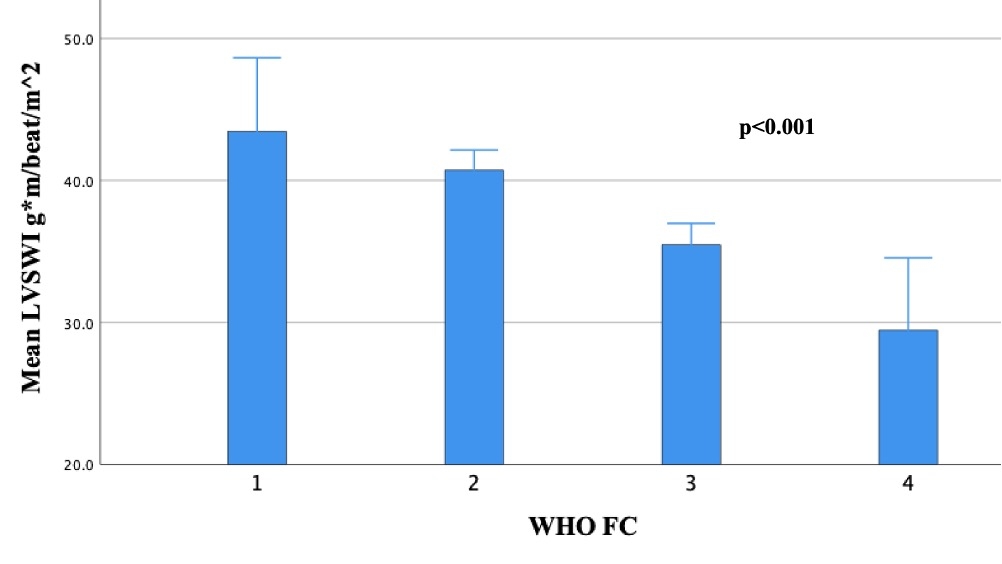Final ID: Mo4153
Relationship between Ventricular Workload and Functional Response to Balloon Pulmonary Angioplasty (BPA) Therapy for Chronic Thromboembolic Pulmonary Hypertension (CTEPH)
Abstract Body (Do not enter title and authors here): Background:
WHO functional classification (FC) is used to evaluate clinical response to BPA therapy and is associated with hemodynamic improvements in CTEPH patients. The relationships between FC and specific metrics of left and right ventricular workload during BPA remain unclear.
Methods:
CTEPH patients who underwent at least six BPA sessions and were included in the UCSD BPA registry were included for analysis. Left ventricular (LV) and right ventricular (RV) cardiac power output (CPO) and stroke work index (SWI) using thermodilution cardiac output were measured, along with FC, during each BPA session. BPA “responders” showed improved FC from III/IV at baseline to I/II after BPA therapy. BPA “non-responders” had unchanged FC III/IV symptoms before and after BPA therapy. ANOVA and Student T tests were used and P-value <0.05 was significant.
Results:
A total of 66 subjects (55.5% female, BMI 28.3±6.10kg/m2,16.7% prior pulmonary thromboendarterectomy surgery) were enrolled. Greater subject functionality by FC was significantly associated with higher LVCPO (class IV to I: 0.88±0.15, 0.94±0.28, 1.08±0.31, 0.95±0.27 watt; p<0.001), higher LVSWI (29.4±6.6, 35.6±9.4, 40.8±8.8, 43.4±11.1 g*m/beat/m2; p<0.001), and lower RVCPO (0.37±0.10, 0.34±0.12, 0.34±0.14, 0.24±0.09 watt; p=0.003). RVSWI was not significantly associated with FC (14.8±3.7, 15.4±5.1, 15.1±5.0, 12.5±3.3 g*m/beat/m2; p=0.075). Likewise, higher mean LVCPO (1.1±0.30 vs 0.93±0.27 watt; p<0.001) and LVSWI (41.1±9.1 vs 35.2±9.4 g*m/beat/m2; p<0.001), but not RVCPO or RVSWI, were observed in subjects with FC I/II versus FC III/IV symptoms. BPA responders versus non-responders had higher overall LVCPO (1.01±0.27 vs 0.89±0.27 watt; p<0.001) and LVSWI (39.0±8.9 vs 33.2±8.4 g*m/beat/m2; p<0.001), but not RVCPO (0.33±0.13 vs 0.34±0.13 watt; p=0.465) or RVSWI (15.2±4.8 vs 14.9±5.1 g*m/beat/m2; p=0.694). Responders also had higher baseline LVSWI (p=0.029) and post-BPA LVSWI (p=0.028) compared to non-responders.
Conclusions:
CTEPH patient functionality and symptoms during BPA therapy are associated with metrics of left and right ventricular workload. Patients with more severe FC III/IV symptoms produce lower LV workload. Treatment responders with improved FC after BPA therapy achieve higher overall, pre-BPA, and post-BPA LV workload. Specific metrics of ventricular workload may be helpful determinants of CTEPH patient symptoms and BPA treatment response.
WHO functional classification (FC) is used to evaluate clinical response to BPA therapy and is associated with hemodynamic improvements in CTEPH patients. The relationships between FC and specific metrics of left and right ventricular workload during BPA remain unclear.
Methods:
CTEPH patients who underwent at least six BPA sessions and were included in the UCSD BPA registry were included for analysis. Left ventricular (LV) and right ventricular (RV) cardiac power output (CPO) and stroke work index (SWI) using thermodilution cardiac output were measured, along with FC, during each BPA session. BPA “responders” showed improved FC from III/IV at baseline to I/II after BPA therapy. BPA “non-responders” had unchanged FC III/IV symptoms before and after BPA therapy. ANOVA and Student T tests were used and P-value <0.05 was significant.
Results:
A total of 66 subjects (55.5% female, BMI 28.3±6.10kg/m2,16.7% prior pulmonary thromboendarterectomy surgery) were enrolled. Greater subject functionality by FC was significantly associated with higher LVCPO (class IV to I: 0.88±0.15, 0.94±0.28, 1.08±0.31, 0.95±0.27 watt; p<0.001), higher LVSWI (29.4±6.6, 35.6±9.4, 40.8±8.8, 43.4±11.1 g*m/beat/m2; p<0.001), and lower RVCPO (0.37±0.10, 0.34±0.12, 0.34±0.14, 0.24±0.09 watt; p=0.003). RVSWI was not significantly associated with FC (14.8±3.7, 15.4±5.1, 15.1±5.0, 12.5±3.3 g*m/beat/m2; p=0.075). Likewise, higher mean LVCPO (1.1±0.30 vs 0.93±0.27 watt; p<0.001) and LVSWI (41.1±9.1 vs 35.2±9.4 g*m/beat/m2; p<0.001), but not RVCPO or RVSWI, were observed in subjects with FC I/II versus FC III/IV symptoms. BPA responders versus non-responders had higher overall LVCPO (1.01±0.27 vs 0.89±0.27 watt; p<0.001) and LVSWI (39.0±8.9 vs 33.2±8.4 g*m/beat/m2; p<0.001), but not RVCPO (0.33±0.13 vs 0.34±0.13 watt; p=0.465) or RVSWI (15.2±4.8 vs 14.9±5.1 g*m/beat/m2; p=0.694). Responders also had higher baseline LVSWI (p=0.029) and post-BPA LVSWI (p=0.028) compared to non-responders.
Conclusions:
CTEPH patient functionality and symptoms during BPA therapy are associated with metrics of left and right ventricular workload. Patients with more severe FC III/IV symptoms produce lower LV workload. Treatment responders with improved FC after BPA therapy achieve higher overall, pre-BPA, and post-BPA LV workload. Specific metrics of ventricular workload may be helpful determinants of CTEPH patient symptoms and BPA treatment response.
More abstracts on this topic:
Analysis of Burden and Prevalence of Pulmonary Artery Hypertension across 32-years: An analysis for the Global Burden of Disease 2021
Rath Shree, Naintara Fnu
A Non-invasive In Vivo Experimental Model of Heart Failure Using Optogenetic Tachypacing in Larval ZebrafishSavoie Emma, Ramadan Ahmed, Purvis Katherine, Stoyek Matthew, Quinn Alex

